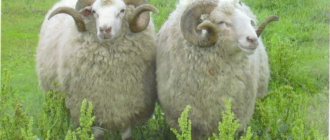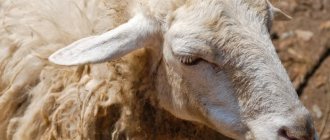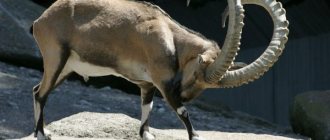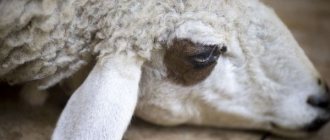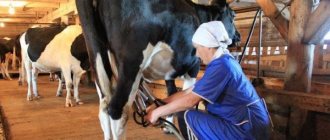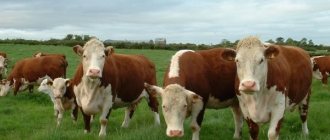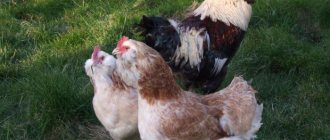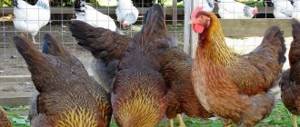Dorper is a breed of sheep that has many advantages - the animals are unpretentious in food and care, and grow quickly. Dorpers are bred for their meat and skin. You can’t cut the fur from them - in winter it is almost absent, and by summer the animals shed completely.
Dorper is a breed of sheep
However, there are traditionally few purebred sheep in the average village. At best they will be Romanovskys, at worst they will be crossbreeds. Without detracting from the advantages of this breed, we want to talk about a meat breed, which, even despite its high price, can increase the return on investment of a flock several times.
The photo shows Dorper sheep
Dorpers - what are the benefits?
The high price for breeding young animals of this breed is justified; these animals have the following advantages:
- ease and speed of reproduction. One ewe gives birth to 2 to 5 cubs. Childbirth is most often easy and does not require human intervention. Lambs rarely die and grow quickly. Sexual maturity for yamkas occurs at 8 months;
- resistance to parasites. This valuable feature is fixed genetically. The Dorper body is resistant to helminths and skin parasites. It is enough to carry out deworming once a year for prevention;
- rapid weight gain. One of the well-known foreign breeders of the breed, Henry Soderberg, told reporters that the lambs on his estate gain 400 grams daily. And this seems to be true; by the age of one month, babies gain from 7 to 20 kg and weigh 12-25 kg. Adult animals are very massive, one-year-old females weigh 60-70 kg, and the largest males by this age can gain over a hundredweight of live weight. And the weight of the champions exceeds 130 kg;
- unpretentiousness in food. Dorpers can be grazed on pastures even with sparse vegetation.
Dorpers are unpretentious, and their maintenance and breeding are very profitable
Even with such an extreme diet, high quality products are obtained when slaughtered.
- Dietary meat. Its yield from a well-fed ram can reach 60 kg. Fat is distributed in muscle tissue not in thick layers, as in the usual lamb, but evenly. Thanks to this, the meat is uniformly tender and compares favorably with ordinary lamb, which is dotted with thick layers of yellowish fat with a characteristic odor. There are no dorpers in the meat and no specific “mutton” taste.
Valuable qualities of meat
- Leather. Dorper skins are excellent for dressing, have a uniform thickness, and are therefore highly valued.
Dorper. Productivity indicators
Productivity indicators
Fat-tailed sheep are a quality source of meat. The slaughter yield for such animals is 53-60% (depending on the breed). In addition, the meat itself is distinguished by fine fibers, juiciness and good taste.
Also, representatives of breeds with a fat tail suggest high milk production. On average, one animal produces up to 60-70 kg of milk during the lactation period, and Awassi sheep bred in Israel have an annual milk yield of about 270 liters. Moreover, such dairy products require a fat content of at least 6% and an increased amount of protein, which makes it especially healthy.
Awassi sheep breed
Fat-tailed cattle are also bred for wool. The average length of the coat of such animals is 10-17 cm. This fleece is used in the production of carpets, felt boots, and rough winter clothing. Up to 2.5-3 kg of wool is sheared from one adult sheep per year. For sheep, this figure is lower and the annual shearing is 2 kg. After processing, about 55-65% of wool remains from the indicated volumes of raw materials, suitable for further use.
Origin
In the 30s of the last century, the agricultural department of South Africa faced a non-trivial task - to provide the population of this semi-desert country with dietary meat. They approached its solution creatively, deciding to sponsor work on breeding a breed of sheep that could feed on local sparse vegetation, live on free grazing and not get sick, while gaining weight suitable for slaughter in the shortest possible time.
For this purpose, African breeders crossed four breeds - Dorset Horn, Persian black-headed ram, Merino and fat-tailed sheep.
The name of the breed is also “hybrid”. The first syllable is taken from "dorset horn", the second - from "Persian black-headed ram". From the latter, the new breed inherited not only three letters, but also a spectacular coloring.
Dorpers are the result of long, careful selection
The new breed of sheep has exceeded all scientists' expectations. The animals actively gained weight by eating low, sun-bleached grass of the African savannah. Even the absence of water for up to two days does not affect the well-being of these wonderful animals.
But the first sheep of this breed came to Europe only thirty years later, in 1966. A little later, they were appreciated by sheep farmers in America and Australia. Already in the 21st century, Dorpers began to be bred in Canada, in regions with a climate similar to Russia. It turned out that this African breed adapts perfectly to a temperate continental climate. Even cold, snowy winters do not cause health problems in sheep.
Description and characteristics
Fat-tailed sheep are hardy and unpretentious, are content with worse pastures than Merino sheep, and are not prone to contracting scabies and other skin diseases.
Tuvan breed of sheep
Due to the significant distribution of this group of sheep, there is a wide variety of breeds, differing both in the length and shape of the tail, and in the number of caudal vertebrae. There are both horned and polled breeds, with long drooping and erect ears. In some breeds the tail is straight and goes down to the ground, while in others it is curved once or twice. There is little accurate information about the number of tail vertebrae in various broad-tailed breeds, usually 13-20 vertebrae, but there are breeds with both shorter and longer tails. Attempts to establish certain subgroups of fat-tailed sheep based on the length and shape of the tail must still be considered unsuccessful, since there is no definite data regarding the number of caudal vertebrae and other characteristics accompanying the tail.
Ram of the Karachay breed
Conventionally, fat-tailed sheep can be divided into 4 subgroups:
- sheep with a straight, uncurved tail;
- sheep with a tail curved at the bottom in the form, the tip of the tail is either skinny or with a slight deposit of fat;
- long-tailed sheep have a tail curved at the bottom; fat is deposited throughout, not excluding the tip;
- sheep with a short or medium-length tail that curves up and then down in the middle. The tip of the tail is skinny.
Lambs of the Karakul breed
The most common fat-tailed breeds are:
- Awassi;
- Afrikaner;
- Afshari;
- Damara;
- Lezginskaya;
- Karakulskaya;
- Karachaevskaya;
- Rahmani;
- Tuva;
- Chios.
Exterior
Dorpers are large, well-built animals with a massive, slightly elongated body. The muscles of the thighs and back are well developed. The coat is sparse, coarse, short, and consists of guard hairs and undercoat. Its color can vary from white to light gray. The hair growth is uneven, the neck, chest and saddle become thicker, and there is almost no hair on the belly. The skin on the body, neck and legs is white. The skin on the head and upper neck is black and may gather in folds. Legs are short and bare.
Dorper sheep
Horns are absent in sheep; in rams they grow rarely and usually appear as tubercles 2-3 centimeters high. The fur on the forehead may curl in the manner of a karakul, especially in rams.
There are two subspecies of dorpers.
- Blackheads , whose head and upper neck are uniformly colored black.
- Whites who are genetically devoid of this feature.
White Dorper
Life expectancy can exceed 15 years, but after 5-8 years, maintenance ceases to be economically justified.
Origin story
Asia Minor, Armenia, Persia and Syria can be considered the homeland of fat-tailed sheep. The tail of the Syrian sheep reached a particularly significant length and width, and historical grounds give the right to assume that from Syria the fat-tailed sheep spread throughout Egypt, Persia and other parts of Asia, northern Africa and Europe.
Damara lambs
The formation of the cultural type of broad-tailed sheep with a huge tail and good quality wool dates back to ancient times. Namely, this sheep was called noble in Syria, Persia and Egypt, i.e. - cultural. The most famous breeds of Asia were considered the Anatalian and Syrian fat-tailed sheep, in which the tail, reaching the heel, curved towards the top.
In the Bible we find many references to the fat tail; apparently, the ancient Israelites bred this type of sheep 1700-1800 years before the beginning of our era. Drawings of Egyptian monuments from the 17th dynasty from 1800 years before the beginning of our era depict a sheep with a long and fat tail. The ancient Egyptian fat-tailed sheep had spiral-curved horns, short erect ears, a hooked head and a tail that reached down to the heels.
Even 500 years before the beginning of our era, the palace of Xerxes in Persepolis was decorated with images of two broad-tailed rams.
Awassi sheep
Dorpers in Russia
Purebred sheep of this breed are very rare in our country. Potential breeders are put off by high prices. Breeding cattle cost from 6 thousand dollars, young animals - from one and a half thousand. This price category is also relevant for Russia, of course, at the ruble exchange rate. Therefore, they mainly import seed material, which is used to fertilize queens of local breeds. If there are conditions for embryo implantation, they are purchased in Canada, Australia, and the USA.
In 2014, they wanted to breed Dorpers in the Belgorod region. Kalina LLC was created with a budget of 11.5 million rubles. The plans were to raise 250 or more heads annually starting in 2021. But due to the crisis, or for some other reason, this good initiative died out ingloriously.
A flock of Dorper sheep
Important! If Dorpers are sold for much less, they are often phenotypically indistinguishable crosses with Romanov sheep. Be carefull.
Hybridization with Romanov sheep
Domestic farmers are actively crossing Dorpers with Romanov sheep, producing good hybrids. Due to the high cost of breeding rams, the seed of Dorper rams is often used for this purpose, which is used to inseminate Romanov ewes.
Romanov sheep
The offspring of the first generation are completely black-spotted and hornless. Hair like Dorpers.
From the black-headed short-tailed females of the first generation, the most precocious ones are selected and again crossed with a Dorper ram or fertilized with sperm. Half of the offspring are animals with black-spotted color, 25% are black and black-headed.
The best-performing black-headed females from the second generation are also inseminated with Dorper sperm. 90% of the offspring will be so similar in appearance to Dorpers that the difference will only be noticeable to a specialist or breeder. Unfortunately, the resulting hybrids are much inferior to purebreds in terms of meat quality, early maturity and daily weight gain.
Description of Dorpers
The animals look very well-groomed due to the fact that their fur is short. These animals are not subject to seasonal haircuts, as they molt, which occurs in the spring. Due to this feature of the coat, Dorpers are classified as hairless sheep. There are areas on the body with coarse hair, which is located in the neck, back and sides. The color of the coat in these areas is light gray, and can sharply turn into a dark color. The lower part of the body is without hair. The limbs are short and also have no hair. These sheep received their black head color from black-headed Persian parents. The ears are small and also black. The skin on the neck is in folds. The hair is brightly polled, and the rams have horns. Some animals of this breed, in whose veins Merino blood flows, are completely white in color, the ears are pinkish, and curled hair is observed between the ears. There is no hair on the face.
Reproduction
Dorpers are one of the fastest maturing breeds. Sexual maturity in males occurs at five months, in females at eight. However, it is not recommended to breed animals before they reach one and a half years of age. The offspring of young sheep are few in number, grow worse and get sick more often.
Rams have high seed productivity and are able to inseminate up to 100 sheep at a time. However, to improve the quality of the semen, it is recommended to adhere to the ratio of one ram per 15-20 sheep. To achieve good results, they must receive good nutrition and exercise more. Therefore, it is preferable to keep producers not in stalls or pens, but in fenced pastures.
Dorper sheep
Both females and males of this breed are able to reproduce year-round, because of this, childbirth is not tied to a specific season and can be repeated every eight months, and pregnancy lasts 4-5 months.
Important! It is better to choose the time for mating so that the lambs are born in late February - early March. They will grow better and get sick less. To do this, they need to be brought together with the manufacturer or artificially fertilized in late September-early October.
Abroad, females and males are most often kept in the same herd and mate uncontrollably. But this option is only suitable for beef herds. When breeding, it is recommended to keep rams separately and allow them to approach sheep only during certain periods when:
- the sheep becomes nervous, restless, eats poorly and screams;
- jumps on other animals;
- The external genitalia of the sheep become red and swollen, and a mucous secretion is released from them.
| 1-2 months | 3-4 months | |
| Silage | 2-3 kg | 3—3.5 kg |
Beet | 1 -1.5 kg | 1 kg |
Hay and straw | 1 -1.5 kg | 1.3 -1.7 kg |
Concentrates | 0.2—0.3 kg | 0.2—0.3 kg |
Salt | 10-15 g | 10-15 g |
After 4 months of pregnancy, the ewe should be switched to a diet consisting of lighter and more nutritious feed. She is placed in the brood stall
The first lambing usually consists of one young, but on average the queen gives birth to 2-3 lambs, in some cases their number can reach 4-5. Childbirth is most often problem-free and does not require the owner’s help. The size of the skeleton, in particular, the volume of the head of newborns, is such that they easily pass through the birth canal without causing ruptures. The weight of newborn Dorpers ranges from 2 to 5 kg. As a rule, they quickly get to their feet and after a quarter of an hour they are already able to follow their mother.
Raising lambs
Dorper sheep breed
No later than half an hour after lambing, the lamb should stand on its legs and drink colostrum. If this does not happen, no later than 2 hours after lambing, the uterus should be milked and the baby should be given a drink from the nipple. He must drink at least 50 ml per hour.
In ewes, the instinct to care for offspring is fully manifested. They take care of the cubs and protect them. They have a lot of milk, enough even for 3-4 lambs. But sometimes there is not enough milk. This is easy to notice if you look closely at the lambs. If, under the age of five days, they sleep all the time, waking up only to attach themselves to their mother’s nipples, this is normal. If they stand near their mother most of the time and suck, they don’t have enough milk. But these are abnormal variants that are most often found in mothers who gave birth before one year or after 8 years.
Dorper sheep and lamb
Live weight gain of Dorper lambs
| Age, days. | Weight, kg. |
| 1 | 2-5 |
| 30 | 12-25 |
| 60 | 25-40 |
| 90 | 30-55 |
| 180 | 55-70 |
It is advisable to raise young Dorpers using a joint method. It consists in the fact that until they reach two weeks of age, the babies are left in the uterine pen. Ewes graze in a pasture or in a paddock, and every three hours they are allowed near the children for feeding.
Dorper sheep and lamb
By the age of one month, babies increase the weight with which they were born by 3-4 times. Until the age of three months, they feed on mother's milk. Then they are taken away from the ewe and kept separately.
Breeding young animals
Video - Dorper: breed of sheep
Care
Ideal for dorpers is pasture housing, when the animals spend most of the year on pastures or in large fenced enclosures. Mobile ones are best. As the grass in the fenced area dries out, the fence is dismantled and moved to a neighboring area.
Maintenance of Dorpers
With the onset of cold weather, animals are transferred to sheepfolds. The premises should be spacious, bright, without drafts, to which Dorpers are very sensitive. Ventilation and heating system must be required. In group stalls, one individual should have at least 1.5 sq.m. area, in individual ones - not less than 2.5. The queen with lambs needs even more space. With one lamb - 3.2 sq.m., with each subsequent lamb the total area is increased by another 0.7 sq.m.
Feeders and drinkers are built in the shape of long troughs. Their length should be sufficient so that all the inhabitants of the stall can eat or drink at the same time without jostling each other. Feeders in the uterine compartments are placed higher than usual, so that dairy lambs cannot jump inside.
Sheep near the feeder
However, even at sub-zero temperatures it is necessary to provide animals with the opportunity to walk. Domestic breeders write on forums that the Russian winter is not a hindrance for Dorpers, even despite the lack of wool. At a temperature of minus 15 degrees Celsius, Dorpers can be outside along with other domestic sheep; at a temperature of -20 degrees Celsius, the sheep leave the barn for half an hour and come back together.
Dorpers in the pasture
Video - Dorper. Breeding sheep and rams
Types of fat-tailed sheep
Most breeds of fat-tailed sheep appeared and developed in Asia and the Caucasus. Their origin is unknown for certain, but, despite the large number of diverse theories, all researchers agree that this is a very ancient breed. Their images were engraved on bas-reliefs dating back to the 3rd millennium BC. This find was discovered on the territory of the ancient state of Assyria.
The fat tail of such animals acts as a reserve source of nutrients. The sheep's body uses them in cases where, due to harsh climatic conditions, ordinary food is not enough for the body. Depending on the form of education, it is classified as one of four types:
- Small rounded. This tail is only slightly larger than a regular sheep's tail.
- Small with a thin ending.
- Overhanging. The fat formation in this case is triangular in shape.
- Large S-shaped. This tail involves several bends and a significant length. In addition, this trait becomes dominant when crossed with sheep that have a different type of tail. Therefore, young animals inherit this characteristic almost without exception.
Fat-tailed sheep are also classified based on their body features. It could be:
- strong;
- rude;
- tender.
The prevailing type largely depends on the breed of the animal.
